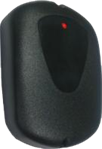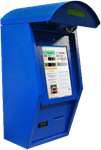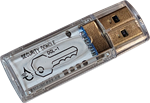Wireless interface converter for petrol stations
PURPOSE
Various wired interfaces are often applied for communication exchange between electronic devices at petrol station: RS-232, RS-485, RS-422, current loop, others. These interfaces have many benefits, but all of them have a common disadvantage – they are wired, so require putting of cabling for connection. As a rule wires are put in underground pipes, which requires excavation (removing the top layer of asphalt or other cover, digging of trenches, laying of cables, etc.).
Wireless communication is an alternative to wired connection, it simplifies the whole process and eliminates a necessity of placing cabling – electronic devices are able to communicate, but communication is done over-the-air instead of wired cabling. RFC converter serves for establishing of wireless communication between the devices and have advantages as quick of mounting, flexibility of settings, high noise immunity and others.
Wireless interface converter RFC for petrol stations is appointed for establishing of wireless communication between devices having interfaces RS-232 and RS-485. RFC converter does not bring any changes to exchanged data between devices, thus RFC converter is a complete analogue to wired cabling connection with the only exception of 35 ms delay at start of data transmission. Data is encrypted during transmission using keys (changing at each data packet transfer), which set the final user can program in the RFC converters at configuration.
RFC interface converter board:


Click on image to enlarge
RFC interface converter in mounting box:

 |
 |
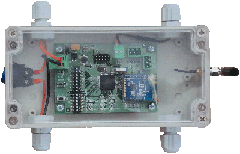 |
EXAMPLE OF APPLICATION ON PETROL STATION
Application of RFC converter allows to minimize wires placing on petrol station and fasten installation:

Click on image to enlarge
TECHNICAL CHARACTERISTICS
Specification:
| Nominal power supply voltage | 12 V DC |
|---|---|
| Power supply voltage range | 9 … 18 V DC |
| Wired interfaces | RS-232/RS-485 |
| Temperature range | from -20°C to +60°C |
| Weight | 45 g |
| Overall dimensions | 85 x 58 x 25 mm |
Wireless communication parameters:
| Transmission frequency | 433 MHz |
|---|---|
| Modulation type | GFSK |
| Output power | not more than 10 mW |
| Baud rate | 10000 bits/sec |
| Delay at transmission | 35 ms |
| Encryption at transmission | RTEA using user-configurable encryption table |
Wired communication parameters:
| Communication protocol | any |
|---|---|
| Baud rate | 1200 … 115200 |
| Data format |
- 5 … 8 data bits - 1 stop bit - odd/even/none parity control |
| Data length | up to 270 bytes |
| Sign of data end | delay of more than 3.5 bytes |
CONNECTION SCHEME
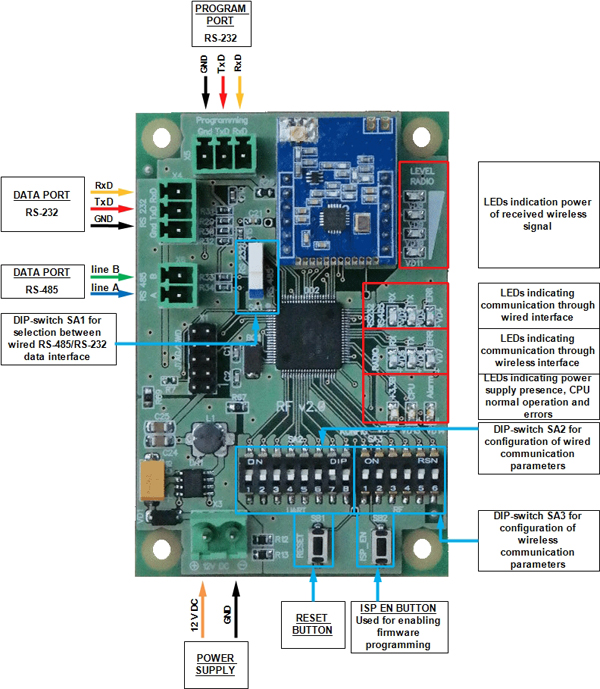
Click on image to enlarge
ORDER INFORMATION
 |
RFC interface converter PCB board with terminal blocks Order code: RFC-PCB-001 |
|
 |
RFC interface converter board in mounting box Order code: RFC-BOX-001 |
|
 |
RFC interface converter board in mounting box together with PTS controller over fuel dispensers and ATG systems Order code: RFC-PTS-001 |
1. What is the radio frequency used in wireless communication device and is it allowed to be used on the petrol station?
WCD is designed to transmit / receive data via radio channel at a speed of up to 9600 bit / s in the frequency range (2410-2465) MHz with the transmitter output power up to 10 mW. Due to such a small output power it is allowed to use WCD without certification (2.4 MHz is a free from licensing radio frequency)
2. Where is the WCD installed and does it require ATEX approval?
WCD is to be installed in an explosion safe area (for example inside the dispenser box), since than it does not need ATEX approval.
3. What interfaces does WCD allow to prolong wireless?
These are RS-232 and RS-485 (2 wires) interfaces.
Ask YOUR questions about
"Wireless interface converter for petrol stations"
Other products of section:

|
ISPD-485 device for RS-485 interface isolation and surge protection
ISPD-485 device is used for isolation and surge protection of RS-485 interface lines. The ISPD-485 is installed in the RS-485 line to protect equipment from high-voltage impulse interferences caused by: lightning discharges, radiation from industrial equipment, various electromagnetic fields.
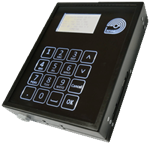
|
Pinpad self-service terminal for petrol stations
Self-service terminal Pinpad is a terminal intended for provision of self-service at petrol stations. It has wired/wireless communication and is equipped with a built-in display, keyboard, RFID-reader (Mifare/Em-Marine standards) and Wi-Fi module, which allows it to be used for following purp

